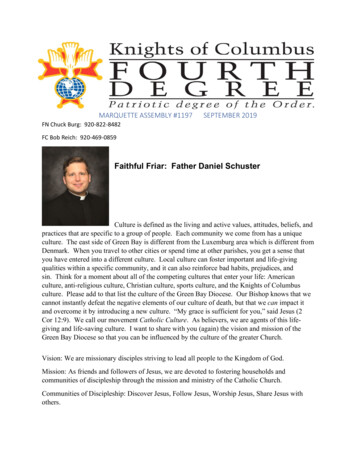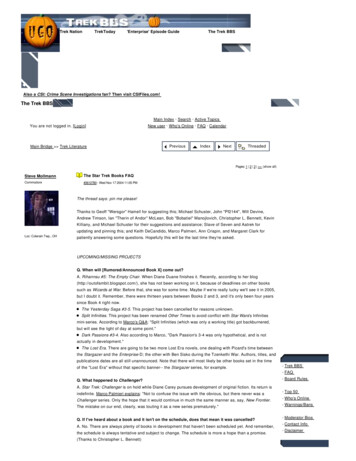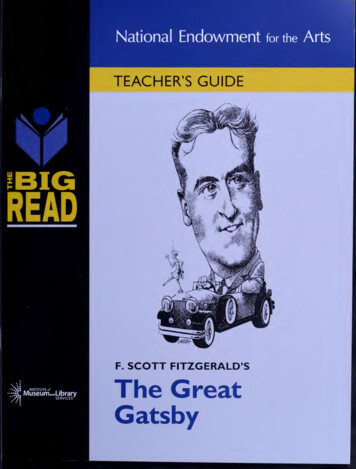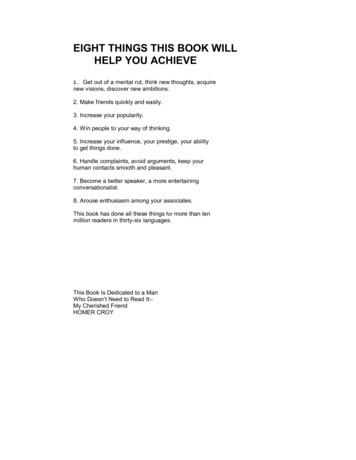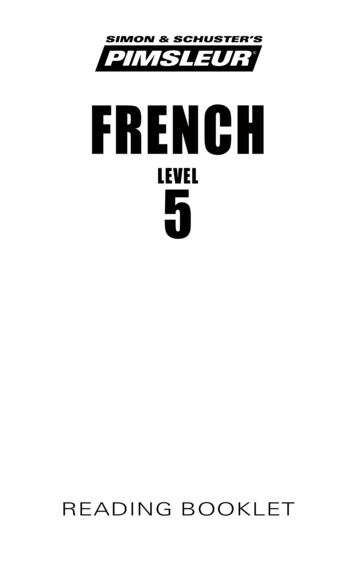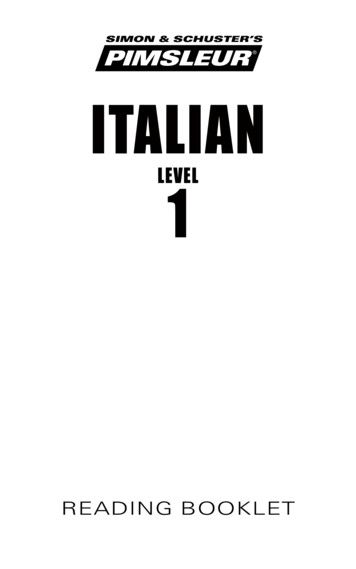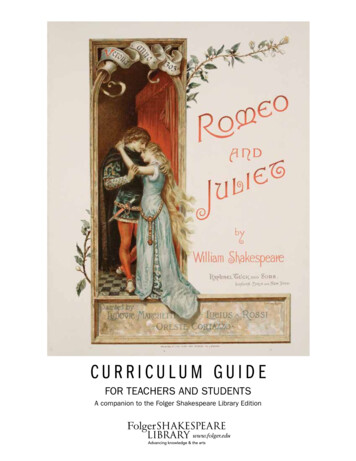
Transcription
Curriculum Guidefor teachers and studentsA companion to the Folger Shakespeare Library Edition
Inside this guideShakespeare is for Everyone!Overview from Folger EducationRomeo and Juliet SynopsisCharacters in Romeo and JulietFrom One Classroom Teacher to AnotherTips for Teaching ShakespeareTeaching Shakespeare FAQs2 Lesson PlansFamous Lines and Phrases from Romeo and JulietRomeo and Juliet Fact SheetSuggested Additional ResourcesAbout the FolgerO n t h e co v e r :Lucius Rossi. Title page for Romeo and Julietby William Shakespeare. London, 1890. FolgerShakespeare Library.See more images of Romeo and Julietfrom the Folger collection atwww.folger.edu/digitalcollection.Images: 1) William Shakespeare. Romeo and Juliet. London, 1637. Folger Shakespeare Library.2) James Northcote. Romeo and Juliet, act V, scene III, Monument belonging to the Capulets: Romeoand Paris dead, Juliet and Friar Laurence. Oil on canvas, ca. 1790. Folger Shakespeare Library. 3) JohnGregory. Romeo & Juliet bas relief, marble 1932. Folger Shakespeare Library. 4) West Side Story souvenirbooklet. New York, 1961. Folger Shakespeare Library.
At the Folger, we loveto see students takeShakespeare and makeit their own. We believethat Shakespeare isfor everyone and thatstudents of all ability levelscan successfully engagewith his works.Shakespeare isfor Everyone!Shakespeare isn’t an antiquated art form. His plays are full of explosive familysituations, complex relationships, and deep emotions that today’s students can—and do—relate to. At the Folger Shakespeare Library, we love to see students takeShakespeare and make it their own. We believe that Shakespeare is for everyone andthat students of all ability levels can successfully engage with his works.The best way to learn Shakespeare is to do Shakespeare. What does this mean?Put simply, it is getting students up on their feet and physically, intellectually,and vocally engaging with the text. We believe that students learn best usinga performance-based methodology and that performance can build a personalconnection with the text that traditional teaching methods may not.Performance—which is not the same thing as “acting”—activates the imagination.Active learning invigorates the mind and stays with the learner. Shakespeare’sgenius with language, his skill as a dramatist, and his insight into the humancondition can instill even the least academic student with a passion not only forShakespeare but also for language, drama, psychology, and knowledge.The Lesson Plans and Tips for Teaching Shakespeare included in this CurriculumGuide provide practical, classroom-tested approaches for using performancebased teaching techniques. We have also included a Synopsis, a Fact Sheet,and Famous Lines and Phrases from the play and interesting facts to share withstudents.Remember that enthusiasm is more important than expertise. There is alwaysmore for everyone to learn, so enjoy the ride with your students!Photos from Folger student Shakespearefestivals, classroom visits, and teacherworkshops by Mignonette Dooley, MimiMarquet, Deidra Starnes, and Lloyd Wolf.Robert YoungDirector of EducationFolger Shakespeare Library
Above: Nicole Lowrance (Juliet) and Graham Hamilton (Romeo). Below: Nicole Lowrance (Juliet). Romeo and Juliet, directed by PJ Paparelli, Folger Theatre, 2005. Photos by CarolPratt. Folger Shakespeare Library.Romeo&JulietSy n o p s i sIn the city of Verona, the longstanding quarrel between the Montague andCapulet families breaks into violence. Romeo Montague reveals to his cousinBenvolio that he is in love with Rosaline, but that his love is unrequited. Afterlearning that Rosaline will be at a party at the Capulet house that night, Romeo’sfriends convince him to attend in disguise. Romeo meets Juliet, and they fall inlove. During the party, they discover that their families are sworn enemies. FromCapulet’s garden Romeo overhears Juliet express her love for him. When heanswers her, they declare their love and their desire to be married. Friar Lawrenceagrees to secretly marry them, expressing the hope that the marriage may endthe families’ feud. After their marriage, Juliet’s cousin Tybalt challenges Romeo toa duel. Romeo refuses to fight, and his friend Mercutio is killed instead. Romeothen kills Tybalt and is banished from Verona. Juliet’s parents announce thatshe must marry Paris. Grief-stricken, Juliet visits Friar Lawrence who gives her apotion that will make her appear as if she is dead the morning of her wedding.The Nurse finds Juliet in a deathlike trance and she is taken to her family’s burialvault. Romeo hears of Juliet’s death and returns to Verona. He arrives at hertomb and takes poison, dying as he kisses her. Juliet awakens and finds Romeodead and kills herself with his dagger.See more images from Romeo & Juliet at the Folger collection at www.folger.edu/digitalcollection.
Ro m e o a n d J u l i e tCharacter ConnectionsHouse of MontagueHouse of CapuletLady MontagueLord CapuletLady CapuletFather of JulietMother of JulietRomeoDaughter of Lord and Lady Capulet,in love with RomeoTybaltNurseMaid andConfidant toJulietFather of JulietMother of JulietJulietNephew to CapuletLord MontagueSon of Lord and Lady Montague,in love with JulietSecretlyMarriedPetruchioBenvolioCompanion to TybaltPeter Sampson GregoryServants to CapuletCousin to Romeo,Nephew to MontagueBalthasaar AbramServant toRomeoFriarLawrenceServant toapeacefulpriest,Montaguefriend to RomeoFriarJohnHouse of EscalusParisKinsman to the Prince,engaged to JulietEscalusPrince of VeronaMercutioKinsman to the Prince,friend of RomeoPageServant to ParisPeople of VeronaServants Masquers Muscians Gentleman Watchmen Citizensandand WomenandTorchbearersAttendantsCharacter KeyMain Characters in whiteSecondary Characters in blackApothecary
F r o m O n e C l a s s r oo mTeacher to AnotherOnce students can make the language work for them,they have access to the pleasures of the play—thejokes, the heart tugs, the fear, the anger, the thousandsof problems humans create for themselves, and theone or two problems created by outside forces.Dear Colleagues,Learn more at www.folger.edu/shakespearesetfree.Shakespeare. Mere mention of his name is likely to make aclass of freshmen panic, so it is important that a student’sfirst encounter with Shakespeare’s plays be dynamic andengaging. A starting point for this encounter is the very heartof Shakespeare’s work—his language. Shakespeare enthusiastsmay love its rich complexity, but teachers know this samelanguage can be a barrier for students. Once students canmake the language work for them, they have access to thepleasures of the play—the jokes, the heart tugs, the fear, theanger, the thousands of problems humans create for themselves,and the one or two problems created by outside forces.A spirit of flexibility and adventure is a key requirement. Less ismore. There are so many layers and facets in Romeo and Julietthat it is best to help students sample a little and to leavethem wanting to discover more on their own. Participation andinvolvement are the goals.Read on. And as Juliet says, “Hie to high fortune!”See performance-based teaching strategies inaction at www.folger.edu/teachervideos.Susan Biondo-HenchCarlisle High SchoolCarlisle, PAExcerpted from Shakespeare Set Free: Teaching A Midsummer Night’s Dream,Romeo and Juliet, and Macbeth
Tips forTeachingShakespeareAPerforming Shakespeare—even at the most rudimentarylevel, script in hand, stumblingover the difficult words—canand usually does permanentlychange a student’s relationshipwith the plays and their author.t the Folger, we believe thatShakespeare is for everyone.We believe that students of allability levels, all backgrounds, and at allgrade levels can—and do—successfullyengage with Shakespeare’s works.Why? Because Shakespeare, doneright, inspires. The plays are full ofexplosive family situations and complexrelationships that adolescents recognize.Performance is particularly crucial inteaching Shakespeare, whose nakedlanguage on the page may be difficultto understand. “Performance” in thissense does not mean presentingmemorized, costumed, fully stagedshows, although those can beboth satisfying and educational.Performance means getting studentsup on their feet, moving around aclassroom as characters, and speakingthe lines themselves.Remember:1. Enthusiasm is more importantthan expertise—there isalways more for everyone tolearn, so enjoy the ride withyour students!2. Trust Shakespeare’s originallanguage, but don’t labor overevery word.3. Pick out key scenes that speakmost clearly to your students.You do not have to start withAct 1, Scene 1.4. Use the text to explain the lifeand times, not vice versa.The following two Lesson Plans willgive you practical ways to get startedusing this approach in your classroom.Want More?Folger Education’s ShakespeareSet Free Toolkit is a comprehensiveresource for teaching Shakespeare,with lesson plans, activity guides,podcasts, videos, and other teachingtools. Learn more atwww.folger.edu/toolkit.
T e a c h i n g S h a k e s p e a r e FA Q sHow long does it take to teach a play?A Shakespeare unit can take anywherefrom a few days to a few weeks,depending on your students. You maywant to spend a few days to introducethe play’s major characters andthemes, or you could spend a coupleof weeks exploring several scenes, keyideas, and multiple interpretations.Full play units, such as the ones inShakespeare Set Free, can take up tosix weeks to teach. You do NOT needto start with Act 1, Scene 1 and you doNOT need to labor over every word.lines can be interpreted and enacted inmany different ways. One way aroundthis is to start with one scene whichyour students read and perform.Follow this activity by showing clipsfrom several film versions of the samescene. This strategy enables allow forsome meaningful discussion aboutpossible interpretations.Do I need to teach the entire play?Sometimes it is better to do just partof a play rather than the whole play.Or you might opt for a Shakespearesampler, using several scenes fromdifferent plays.Do I need to teach about the GlobeTheatre or Shakespeare’s Life?The simple answer is “No.” Whiletelling students that Shakespeare hadthree children and that he and AnneHathaway had to get married mightbe interesting, it really doesn’t helpthem understand the plays. It’s muchbetter to integrate some facts aboutElizabethan life when they come upin the plays. So when Francis Fluteprotests, “Let me not play a woman. Ihave a beard coming” in A MidsummerNight’s Dream, that’s the perfectopportunity to explain the Elizabethanstage convention of young men playingthe female parts.Which edition of the play is best touse with students?The Folger Shakespeare Librarypaperback editions are relativelyinexpensive, and easy to use, with thetext on one page and footnotes andscene summaries on the facing page.Be aware that Shakespeare plays inliterature anthologies often edit outsome of the more bawdy content—content which students often love. Theyare also very heavy to carry aroundwhen students are performing scenes.You can install the Free ElectronicShakespeare Reader on your harddrive on any Windows computer atwww.shakespeare.ariyam.com. This isa downloadable piece of software thatallows you to have all of Shakespeare’s38 plays instantly at your fingertips.Once you have it, there is no Internetconnection required. It also providesin-depth full-text searching to all ofShakespeare’s plays. You can alsodownload the text online from sites suchas www.opensourceshakespeare.org.Should I start with the movie?One disadvantage with watching a filmversion first is that students equatethis version with the play and havedifficulty realizing that scenes andWhat if I have never read the play before?Learn along with your students—modelfor them the enthusiasm and excitementthat comes with authentic learning.Are student projects helpful?Designing Globe Theatres out of sugarcubes and Popsicle sticks, designingcostumes, creating Elizabethannewspapers in the computer lab, doinga scavenger hunt on the Internet,or doing a report on Elizabethansanitary conditions has nothing todo with a student’s appreciation ofShakespeare’s language. If you wantto give students a project, have themselect, rehearse, and perform a scene.What is a “trigger scene?”A trigger scene is a short scene froma play that introduces the studentsto key characters and plot elements.Most important, the trigger sceneshows students that they can uncoverthe meaning of Shakespeare’s texts asthey “put the scene on its feet.”Tried and true triggerscenes for beginningShakespeare:Romeo and Juliet, 3.5(Juliet angers her parents)Macbeth, 1.3.38 onwards(Macbeth meets the witches)A Midsummer Night’s Dream, 1.2(The rustic actors are introduced)Hamlet, 1.1(Ghost appears to soldiers)Julius Caesar, 3.3(Cinna the poet is attacked by mob)Much Ado About Nothing, 4.1(Beatrice urges Benedick to killClaudio)Othello, 1.1(Iago rudely awakens Brabantio)The Taming of the Shrew, 2.1(The two sisters quarrel)Twelfth Night, 2.2(Malvolio returns ring to “Cesario”)Want More?Folger Education’s ShakespeareSet Free Toolkit is a comprehensiveresource for teaching Shakespeare,with lesson plans, activity guides,podcasts, videos, and otherteaching tools. Learn more atwww.folger.edu/toolkit.
Ro m e o a n d J u l i e t L e s s o n P l a n 11 7 th - cent u ry P ic k u p L inesSteve WilliamsThe Waterford SchoolSandy, UTPlay/Scenes CoveredRomeo and Juliet, 2.2.46–145Meeting the StandardsThe lesson plan covers NCTE Standards9, 11 & 12.What’s On for Today and WhyEven in the 17th century, people usedlines to get dates and inspire love.Students will examine a chapter froma mid-17th century handbook, TheMysteries of Love & Eloquence, Or theArts of Wooing and Complementing,which offers to “young practioners [sic]of Love and Courtship set forms of expressions for imitation.” Reading 17thcentury pick-up lines will give studentsan opportunity to practice reading a17th century text and also provides aninteresting glimpse at language as atool of persuasion; students can easilysee how this relates to the language ofRomeo and Juliet.This lesson will take one class period.What To Do1. Pair up the students and give themcopies of Pickup Lines Handouts 1and 2, from The Mysteries of Love andEloquence.2. Have the students stand several feetaway from their partners and speak thelines alternately to each other.3. Discuss as a class what images,words, ideas, or figures of speech theyheard. Were the lines more comic thanpersuasive? How has the language oflove changed?4. Assign parts and read aloud Romeoand Juliet, 2.2.46-145.5. Discuss the similarities and differences between Romeo and Juliet andthe handbook. Which words and imagesappear in both?6. Divide the students into groups ofthree or four and have them rewrite afew of the handbook’s more persuasivepassages into modern English, tryingto retain the essence of the original.Would any of these lines work today?What You Need Folger edition of Romeo and Juliet Pickup Lines Handouts 1 and 2How Did It Go?Did the students participate fully?Did they observe differences and similarities between Shakespeare’s lovelines and those from the handbook?Which passages did the students findmore persuasive?Were their translations into contemporary English appropriate?Did they have fun?Want more?Find more ideas and resources onteaching Romeo and Juliet atwww.folger.edu/teachingromeoandjuliet
Ro m e o a n d J u l i e t H a n d o u t1 7 th - cent u ry P ic k u p L inesfrom T he M ysteries of L ov e and E lo q u ence 1
Ro m e o a n d J u l i e t H a n d o u t1 7 th - cent u ry P ic k u p L inesfrom T he M ysteries of L ov e and E lo q u ence 2
Ro m e o a n d J u l i e t LESS O N PLAN 2Mixing It Up with Romeo and JulietTanya SmithLiberty High SchoolBrentwood, CAPlay CoveredRomeo and JulietMeeting the StandardsThe lesson plan covers NCTE Standards1-8 and 12.What’s On for Today and WhyHaving students create a soundtrackfor the play, by picking one song torepresent each scene, can help themmake personal connections to the plotas well as get them motivated to morefully understand the language.This lesson may be used as a reviewat the end of reading the play, orstudents may work on the soundtrackas they read. You can allow variableamounts of time at the end of the unitfor students to present their work.This lesson will take 3–4 class periods.What To Do1. If students have seen a film versionof Romeo and Juliet, you may want tobegin by drawing attention to the typeof music used in the film. Otherwise,explain to students that their next assignment will be to create a soundtrackfor a new production of the play. For eachscene, they will need to select a songthat matches its mood and/or action.2. Hand out copies of the SoundtrackPre-planning Worksheet, which will allowstudents to gather information to helpthem with the assignment. For eachscene, they should gather three keyquotes that help explain the mainideas of the scene, and specific lyricsfrom a song that match the quotesthey have found.3. For each scene, ask students towrite a paragraph that explains how thesong they have chosen represents thescene from the play. Students shouldcite text from the play in their analysis.4. Other possible related assignmentsinclude creating a CD wrapper withwhich to present the soundtrack, burning a CD with the songs on it, and/or creating a PowerPoint presentationto help present the students’ choicesto the class. Explain that they shouldonly use music acquired legally ifchoosing the CD option.5. Complete the assignment with apresentation to the class in whichstudents present a few of the choicesthey have made, along with theirreasons for doing so. Conclude witha discussion: which choices seemedmost appropriate, and why?What You Need Folger edition of Romeo and Juliet Soundtrack Pre-planning WorksheetHow Did It Go?Were students able to identify threekey quotes without difficulty? Werethey able to link these quotes withthemes in songs that they know? Didthey find the assignment interesting?Were the final presentations useful inadvancing classroom discussion aboutthe play?Want more?Find more ideas and resources forteaching Romeo and Juliet atwww.folger.edu/teachingromeoandjuliet.
Ro m e o a n d J u l i e t H a n d o u tM i x ing it u pSoundtrack Pre-Planning WorksheetScene Number and BriefSummary of SceneThree Key Quotes that StandOut, including Who Said ThemSong and Specific Lyricsthat Match
Romeo and Juliet has inspired several filmadaptations and interpretations. George Cukor’s1936 film was Hollywood’s first feature-lengthadaptation of a Shakespearean tragedy andstarred 35-year-old Norma Shearer as Juliet and43-year-old Leslie Howard as Romeo.Scholars generally believe thatShakespeare wrote Romeo and Julietin 1595–96, about the same time hewrote A Midsummer Night’s Dream.The play was first published in 1597.Shakespeare most likely borrowed fromseveral sources for the story of Romeoand Juliet, including Arthur Brooke’s TheTragicall Historye of Romeus and Juliet,printed in England in 1562.In 2010, the Royal ShakespeareCompany presented a real-timeversion of the Romeo and Julietstory on Twitter.William Shakespeare’s Romeo andJuliet, directed by Baz Luhrmann andstarring Leonardo Dicaprio and ClaireDanes, mixed Shakespeare’s originallanguage with a modern setting in“Verona Beach.”Did you know?Tourists in Verona, Italy leave loveletters and messages at a housethat once belonged to the Cappellofamily, who some believe inspiredthe Capulets in Shakespeare’splay. The spot is so popular thatthe notes have to be periodicallyremoved to preserve the building.Pop singer Taylor Swift refers toRomeo and Juliet in her charttopping hit, “Love Story.”Learn more atwww.folger.edu/shakespeare.Rock n‘ Roll singer/songwriter Mark Knofflerof Dire Straits wrote a song titled “Romeoand Juliet” that contains the lines “I can’t doeverything but I’d do anything for you / Can’t doanything except be in love with you.”
Famous Lines and PhrasesfromRo m e o a n d J u l i e tDid you know you’re quotingShakespeare when you say A pair of star-crossed lovers Chorus—Pro. 6 sad hours seem long.Romeo—1.1.166If love be rough with you, be rough with love.Mercutio—1.4.27O, she doth teach the torches to burn bright!It seems she hangs upon the cheek of nightLike a rich jewel in an Ethiop’s ear.Romeo—1.5.51–53You kiss by th’ book Juliet—1.5.122But soft, what light through yonder window breaks?Romeo—2.2.2O Romeo, Romeo, wherefore art thou Romeo?Juliet—2.2.36That which we call a roseBy any other word would smell as sweet.Juliet—2.2.46–47Good night, good night. Parting is such sweet sorrowThat I shall say “Good night” till it be morrow.Juliet—2.2.199–201A plague o’ both your houses!Mercutio—3.1.111Death, that hath sucked the honey of thy breath,Hath had no power yet upon thy beauty.Romeo—5.3.92–93 never was a story of more woeThan this of Juliet and her Romeo.Prince—5.3.320–21Alexandre Bida. “Balcony Scene.” Watercolor drawing, c. 19th century.Folger Shakespeare Library.
S u gg e s t e d a d d i t i o n a lResourcesShakespeare Set FreeThe Shakespeare Set Free series offers innovative, performance-based approachesto teaching Shakespeare from the Folger Shakespeare Library, the world’s leadingcenter for Shakespeare studies. This volume includes unit plans on Macbeth, Romeoand Juliet, and A Midsummer Night’s Dream, and day-by-day teaching strategies thatsuccessfully immerse students of every grade and skill level in the language and theplays themselves—created, taught, and written by real teachers in real classrooms.Other volumes focus on Hamlet, Henry IV, Part 1, Othello and Twelfth Night.Available at the Folger Gift Shop 202–675–0308, or www.folger.edu/shop.Shakespeare Set Free ToolkitThink of it as Shakespeare in a box! Everything you need to teach Shakespeare, allin one place: the Doing Shakespeare Right guide to getting started; Shakespeare SetFree curriculum guide; two-line scene cards; a flash drive with instructional videos,podcasts, handouts, scripts, and images; The Play’s the Thing DVD that follows a 5thgrade class preparing for a festival; and the Macbeth Edition DVD, which includes afilm of the smash 2008 Folger Theatre/Two River Theater Company production.Available at the Folger Gift Shop 202–675–0308, or www.folger.edu/shop.Play-by-Play: Romeo & JulietFolger Education’s “Play-by-Play” website section contains resources on each of themost commonly taught plays, all in one place. Find Romeo & Juliet lesson plans,podcasts, videos, and more.Learn more at www.folger.edu/teachingromeojuliet.Making a Scene: Shakespeare in the ClassroomFolger Education’s blog features new ideas, tips, and resources for teachingShakespeare. With the teaching community commenting, Folger educators explorewhat works and what doesn’t in today’s classroom. Join the conversation!Learn more at www.folger.edu/edblog.Bard NotesA monthly update just for teachers with our newest classroom activities, lessonplans, teacher workshops, and more for K–12 educators.Learn more at www.folger.edu/enews.
lcolleclger.edwww.fo er.edu/digitalgwww.fosrkshopurcesoowSreyrhPrima er.edu/teaclgwww.fonanLibrarilibrariaAsk a rldry is a arning,aribLpeareld’sship, leShakes er for scholar e to the wor ryrelgomFd centa primaIt is hoenowne nd the arts. ollection and earlyrybec,ainspiredculture hakespeare terials from th lger istnetnSooaFtcs.itallarges ry for rare m 1750). The h librarygmiadrfgoor–cord0pitalandrepos period (150 gnized rese s in theA wornoitceonlmlcrar conmode nationally re olarly progrrservatiohthe Folgean inte advanced sc tor in the pre howinanoffering ies; an innov tional leader 12; anducatio ucationdEait–rnnKea/edhumFolgradesrials; ad artser.eduge mate is taught in g of cultural an ,lroafr.fwowwearehibitsucerPlanshakesp -winning prod sic, poetry, ex motingnSosseuLrdroan awa s—theater, m ograms. By p his world,nplansspearermpdaShake er.edu/lessonyrilagceprolgand fam Shakespeare during influenof,.swerwutwlecding off the entheurcesderstan reminds us o e effects of poweronsueRyivyertaahealltypy-Pthe Folg orks, the form wn time, and t to thePlay-b er.edu/playbiflgof his w ance on our o ken word. A g enry Claywww.fovitiesisHotcA&Renais ritten and sp industrialist east ofsemkawof the n people from ated one bloceare G idspsekac.Shau/kAmeric he Folger—lo ned in 1932lger.edtof.wwFolger, Capitol—opewr inaterehTSa leade idesU. .&iseehfntiLiovisso’eion divy. It prspeareespearEducat taught toda achers andreShake er.edu/shaklgoOur F kespeare is illions of telgtrainsawww.fohow Sh sources to m 12 each year, rmanceo–reoonline s in grades K ountry in perf ts& Vide castsststcoanhedec, sstud s across thPoddu/pospeare d familyee.rkearghelShnteaching of re festivals a ndbreakingwww.foifecLaentaduacbaseAmeri canlife.orgakespe lishes the gro the FolgerhnSitenreistudmerspeausednd pubies andShake kespeareinarams, a Set Free ser espeare textsgorphapeareShakwww.sShakes , the leading s today.smEdition ican classroolection lectionloreCrmin AFolgeu/coltionwww.folger.edu201 East Capitol Street, SEWashington, DC 20003
Romeo & Juliet bas relief, marble 1932. folger shakespeare Library. 4) West Side Story souvenir booklet. new York, 1961. folger shakespeare Library. inside this Guide On the COver: Lucius rossi. title page for Romeo and Juliet by William shakespeare. London, 1890. folger shakespeare Library. see more images


